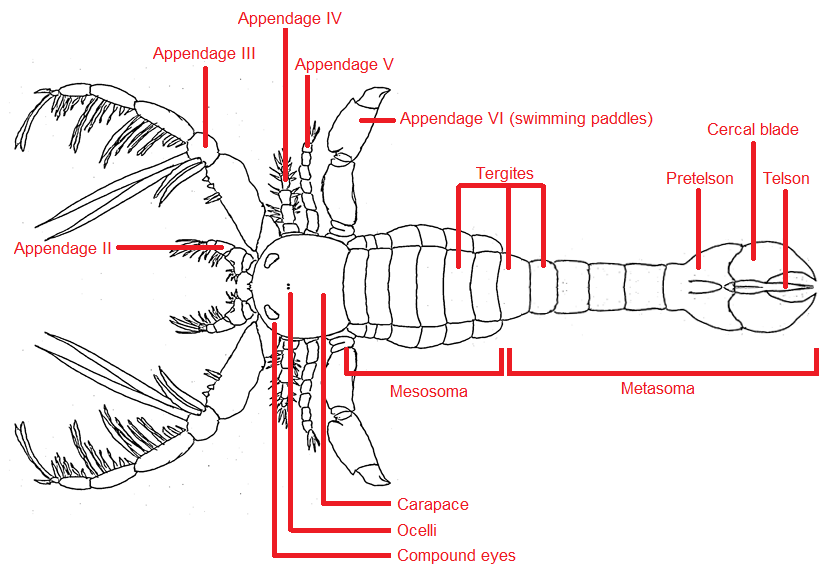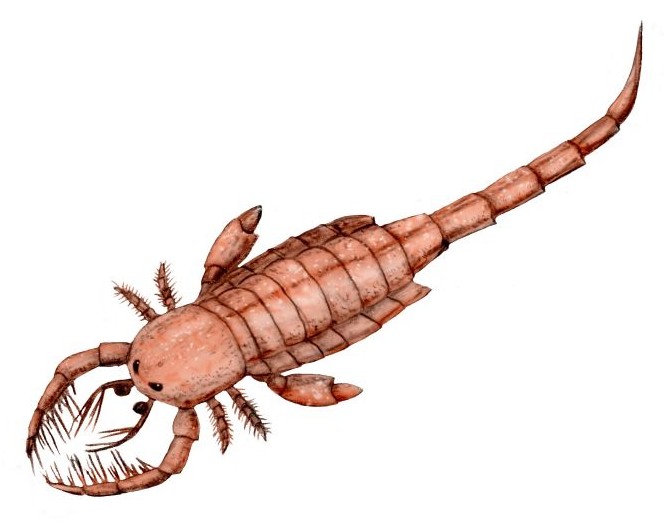|
Echinognathus
''Echinognathus'' is a genus of eurypterid, an extinct group of aquatic arthropods. The type and only species of ''Echinognathus'', ''E. clevelandi'', is known from deposits of Late Ordovician age in the United States. The generic name is derived from the New Latin ''echino''- ("spiny") and the Greek ''gnáthos'' ("jaw"), in reference to a spiny endognathary (used to handle food) appendage part of the fossil type material. ''Echinognathus'' is only known from fragmentary fossil material, consisting of body segments, an appendage used to handle food and possibly other body segments. The genus is distinguished from other eurypterids by the large number of elongated and curved spines, blade-like in life, on its limbs. Initially assumed to represent a species of ''Eurypterus'', these distinguishing features were quickly noticed and deemed important enough to designate ''Echinognathus'' as its own genus. With some additional fossil assigned to ''Echinognathus'' in the early 20th centur ... [...More Info...] [...Related Items...] OR: [Wikipedia] [Google] [Baidu] |
Megalograptus
''Megalograptus'' is a genus of eurypterid, an extinct group of aquatic arthropods. Fossils of ''Megalograptus'' have been recovered in deposits of Katian (Late Ordovician) age in North America. The genus contains five species: ''M. alveolatus'', ''M. ohioensis'', ''M. shideleri'', ''M. welchi'' and ''M. williamsae'', all based on fossil material found in the United States. Fossils unassigned to any particular species have also been found in Canada. The generic name translates to "great writing" and originates from the mistaken original belief that ''Megalograptus'' was a type of graptolite, often given names ending with -''graptus'' (meaning 'writing'). ''Megalograptus'' was a large predatory megalograptid eurypterid, with the largest and best known species, ''M. ohioensis'', reaching body lengths of . Some species were substantially smaller, with the smallest, belonging to a hitherto undetermined species, only growing to about in length. Morphologically, ''Megalograptus'' ... [...More Info...] [...Related Items...] OR: [Wikipedia] [Google] [Baidu] |
Megalograptus Color Reconstruction
''Megalograptus'' is a genus of eurypterid, an extinct group of aquatic arthropods. Fossils of ''Megalograptus'' have been recovered in deposits of Katian (Late Ordovician) age in North America. The genus contains five species: ''M. alveolatus'', ''M. ohioensis'', ''M. shideleri'', ''M. welchi'' and ''M. williamsae'', all based on fossil material found in the United States. Fossils unassigned to any particular species have also been found in Canada. The generic name translates to "great writing" and originates from the mistaken original belief that ''Megalograptus'' was a type of graptolite, often given names ending with -''graptus'' (meaning 'writing'). ''Megalograptus'' was a large predatory megalograptid eurypterid, with the largest and best known species, ''M. ohioensis'', reaching body lengths of . Some species were substantially smaller, with the smallest, belonging to a hitherto undetermined species, only growing to about in length. Morphologically, ''Megalograptus'' ... [...More Info...] [...Related Items...] OR: [Wikipedia] [Google] [Baidu] |
Megalograptidae
Megalograptidae are a family of eurypterids, an extinct group of chelicerate arthropods commonly known as "sea scorpions". The megalograptids were likely the first major successful group of eurypterids, evidenced by a Late Ordovician radiation. All known members of the Megalograptidea are from the Late Ordovician of Laurentia with the exception of the large ''Pentecopterus'' from the Middle Ordovician. Description Megalograptids are characterized by large exoskeletons with ovate to triangular scales. The prosoma (head) is subquadrate, with a tonguelike anterior process bearing marginal spines, and compound eyes on the top front of the head. The chelicerae (claws in front of the mouth) are small and short. The first and third pairs of walking legs are short, with diverging or closely spaced spines. The second pair of walking legs is enormously developed, with long paired spines. The fourth pair of walking legs are nearly spineless. The preabdomen, the front portion of the body, is ... [...More Info...] [...Related Items...] OR: [Wikipedia] [Google] [Baidu] |
Carcinosomatidae
Carcinosomatidae (the name deriving from the type genus ''Carcinosoma'', meaning "crab body")Meaning osomaat ''www.dictionary.com''. Retrieved 7 September 2018. is a family of eurypterids, an extinct group of aquatic arthropods. They were members of the superfamily Carcinosomatoidea, also named after ''Carcinosoma''. Fossils of carcinosomatids have been found in North America, Europe and Asia, the family possibly having achieved a worldwide distribution, and range in age from the Late Ordovician to the Early Devonian. They were among the most marine eurypterids, known almost entirely from marine environments. Carcinosomatids varied considerably in size, from species only a few centimetres in length to some of the largest known arthropods. The largest carcinosomatid species, ''Carcinosoma punctatum'', reached lengths of at least and rivalled the largest eurypterid of all, ''Jaekelopterus'', in size. Morphologically, carcinosomatids were highly distinct from other eurypterids, k ... [...More Info...] [...Related Items...] OR: [Wikipedia] [Google] [Baidu] |
Eurypterid
Eurypterids, often informally called sea scorpions, are a group of extinct arthropods that form the Order (biology), order Eurypterida. The earliest known eurypterids date to the Darriwilian stage of the Ordovician period 467.3 Myr, million years ago. The group is likely to have appeared first either during the Early Ordovician or Late Cambrian period. With approximately 250 species, the Eurypterida is the most diverse Paleozoic Chelicerata, chelicerate order. Following their appearance during the Ordovician, eurypterids became major components of marine faunas during the Silurian, from which the majority of eurypterid species have been described. The Silurian genus ''Eurypterus'' accounts for more than 90% of all known eurypterid specimens. Though the group continued to diversify during the subsequent Devonian period, the eurypterids were heavily affected by the Late Devonian extinction event. They declined in numbers and diversity until becoming extinct during the Permian–Tri ... [...More Info...] [...Related Items...] OR: [Wikipedia] [Google] [Baidu] |
Leif Størmer
Leif Størmer (1 July 1905 – 15 May 1979) was a Norwegian paleontologist and geologist. He was professor of historical geology at the University of Oslo from 1946 to 1975. His father was the mathematician Carl Størmer, and his son the mathematician Erling Størmer. Early life and education Størmer was born in Kristiania (now Oslo) to Fredrik Carl Mülertz Størmer (1874–1957) and Adelaide Clauson (1877–1973). His brother Per Størmer (1907–1991) became a botanist. His sister Henny married landowner Carl Otto Løvenskiold. Leif Størmer attended school in Kristiania, and became interested in paleontology and geology. In 1923, he took his examen artium, and studied thereafter at the University of Oslo. He graduated with the cand.mag. degree in 1928, then the dr.philos. degree in 1931. In 1931–32, Størmer resided in the United States with a Rockefeller Foundation grant. On 23 May 1932, he married Ingegerd ("Tutti") Wiborg Alten (1912–2009) in New York. Career In 1 ... [...More Info...] [...Related Items...] OR: [Wikipedia] [Google] [Baidu] |
August Foerste
August F. Foerste (1862–1936) was an American geologist, science teacher, and paleontologist. Biography Foerste was born on May 7, 1862, in Dayton, Ohio. He studied geology at Denison University, from which he received a bachelor's degree in 1887. Later, he got master's degree at Harvard University in 1888, and PhD in 1890. He served as an assistant for the United States Geological Survey, in Harvard, in which he studied stratigraphy and petrography of New England. After his graduation from Harvard, he studied at the Heidelberg University and College de France for two years. He returned to Dayton in 1893 and became a science teacher at Robert W Steele High School, a position which he kept till his retirement in 1932. In 1896, 1897, and 1899 he spent his summer vacations in Indiana, while conducting geological surveys. In 1908 and 1919 he spent his summers in Ohio, doing his geological surveys there as well. From 1904 to 1912 he was in Kentucky conducting a geological survey; ... [...More Info...] [...Related Items...] OR: [Wikipedia] [Google] [Baidu] |
Ctenopterus
''Ctenopterus'' is a genus of prehistoric eurypterid of the family Stylonuridae. It contains only one species, ''Ctenopterus cestrotus'' from the Early Silurian of Otisville, New York.Dunlop, J. A., Penney, D. & Jekel, D. 2015. A summary list of fossil spiders and their relatives. In World Spider Catalog. Natural History Museum Bern, online at http://wsc.nmbe.ch, version 16.0 http://www.wsc.nmbe.ch/resources/fossils/Fossils16.0.pdf (PDF). Description Stylonurids, which lived from the Ordovician to Lower Permian periods, were small to very large forms with scales developing into tubercules and knobs. The prosoma (head) exhibited variable shape, with arcuate compound eyes located subcentrally, or anteriorly. Their abdomens were slender. Their walking legs were long and powerful, sometimes characterized by spines. Most genera did not have swimming legs. 1955. Merostomata. ''Treatise on Invertebrate Paleontology, Part P Arthropoda 2, Chelicerata'', P36. ''Ctenopterus'' is dis ... [...More Info...] [...Related Items...] OR: [Wikipedia] [Google] [Baidu] |
Stylonurus
''Stylonurus'' is a genus of prehistoric eurypterid of the family Stylonuridae. The genus contains three species: ''Stylonurus powriensis'' from the Devonian of Scotland, ''Stylonurus shaffneri'' from the Devonian of Pennsylvania and ''Stylonurus perspicillum'' from the Devonian of Germany.Dunlop, J. A., Penney, D. & Jekel, D. 2015. A summary list of fossil spiders and their relatives. In World Spider Catalog. Natural History Museum Bern, online at http://wsc.nmbe.ch, version 16.0 http://www.wsc.nmbe.ch/resources/fossils/Fossils16.0.pdf (PDF). The assignment of ''S. perspicillum'' and ''S. shaffneri'' to the genus is doubtful. A previously assigned species, ''S. ensiformis'', is today regarded as synonymous with ''S. powriensis''. Description Stylonurids, which lived from the Ordovician to Lower Permian periods, were small to very large forms with scales developing into tubercules and knobs. The prosoma (head) exhibited variable shape, with arcuate compound eyes located subcen ... [...More Info...] [...Related Items...] OR: [Wikipedia] [Google] [Baidu] |
Mixopterus
''Mixopterus'' is a genus of eurypterid, an extinct group of aquatic arthropods. Fossils of ''Mixopterus'' have been discovered in deposits from Late Silurian age, and have been referred to several different species. Fossils have been recovered from two continents; Europe and North America.Dunlop, J. A., Penney, D. & Jekel, D. 2015. A summary list of fossil spiders and their relatives. In World Spider Catalog. Natural History Museum Bern, online at http://wsc.nmbe.ch, version 18.5 http://www.wsc.nmbe.ch/resources/fossils/Fossils18.5.pdf (PDF). Description ''Mixopterus'' was a medium-sized predatory eurypterid. The largest species, ''M. simonsoni'', reached lengths of 75 cm (29.5 in). It was characterised by a robust exoskeleton with scattered tubercles or semicircular scales. The prosoma (head) was subquadrate, protruding antemedially. The chelicerae (claws in front of the mouth) were small. The two first pairs of legs of ''Mixopterus'' (appendages II and III) were highly specia ... [...More Info...] [...Related Items...] OR: [Wikipedia] [Google] [Baidu] |
Carcinosoma
''Carcinosoma'' (meaning "crab body") is a genus of eurypterid, an extinct group of aquatic arthropods. Fossils of ''Carcinosoma'' are restricted to deposits of late Silurian (Late Llandovery to Early Pridoli) age. Classified as part of the family Carcinosomatidae, which the genus lends its name to, ''Carcinosoma'' contains seven species from North America and Great Britain. Carcinosomatid eurypterids had unusual proportions and features compared to other eurypterids, with a broad abdomen, thin and long tail and spined and forward-facing walking appendages. They were not as streamlined as other groups but had considerably more robust and well developed walking appendages. In ''Carcinosoma'', these spined walking appendages are thought to have been used to create a trap to capture prey in. The telson (the posteriormost division of the body) of ''Carcinosoma'' appears to have possessed distinct segmentation, ''Carcinosoma'' is the only known eurypterid to possess this feature. ... [...More Info...] [...Related Items...] OR: [Wikipedia] [Google] [Baidu] |





